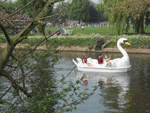2. The analogue world
A very common requirement of computers is to store, view and manipulate photographs or graphical images.
A 'real' image of the world is analogue in nature, you view the world with analogue eyes where colours and tones blend together smoothly.
But computers are digital, they can only handle binary numbers. So if an image is to be handled by a computer, the analogue image from any source has to be converted into a set of binary numbers i.e. you 'digitise' an image with some input device.
For example with a paper photograph you could use a flatbed scanner to convert the image into a binary file. Like this

Scanned paper photo end up as a digital file.
A digital camera has an image sensor that creates binary files directly. These files are then transferred to the computer with an USB cable connection.
But how do you convert an image into a binary file? Read on and find out.
Challenge see if you can find out one extra fact on this topic that we haven't already told you
Click on this link: Binary Numbers
